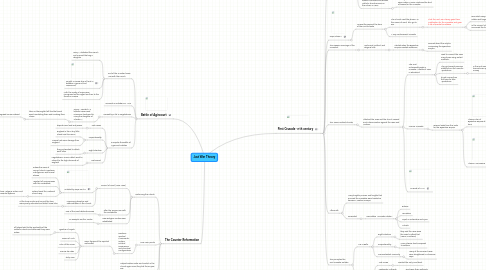
1. Battle of Agincourt
1.1. Part of the Hundred Years War with the French
1.1.1. Henry V defeated the French and married the king's daughter
1.1.2. Fought a narrow strip of land in between Agincourt and Tramecourt
1.1.3. With the Treaty of Troyes was recognized as the regent and heir to the throne in France
1.2. Occured in October 25, 1415
1.3. Caused by a fail in negotiations
1.3.1. Henry V wanted 1.6 billions crowns and numerous lands and to marry the daughter of Charles IV
1.3.1.1. later on the English felt like the french were humilaiting them and mocking their claims
1.3.1.1.1. they agreed on war instead
1.4. Principles the Battle of Agincourt violates
1.4.1. Just Cause
1.4.1.1. dispute over land and power
1.4.2. Proportionality
1.4.2.1. England is like a tiny little island next to France
1.4.2.2. France had more damage than England
1.4.3. Right Intention
1.4.3.1. they just wanted to attack each other
1.4.4. Last Resort
1.4.4.1. negotiations: France didn't want to submit to the high demands of England
2. The Counter Reformation
2.1. Reforming the Church
2.1.1. Council of Trent (1545-1563)
2.1.1.1. initiated by Pope Paul III
2.1.1.1.1. adress the issue of corrupt church members, indulgences, and finacial abuses
2.1.1.1.2. rejected all compromises with the Protestants
2.1.1.1.3. instead used the Medieval Church way
2.1.1.2. improving discipline and administration in the church'
2.1.1.2.1. at the time monks and nuns at the time were poorly educated and didn't know latin.
2.1.2. after the 30 year war with the Protestants
2.1.2.1. one of the most destructive wars
2.1.3. New Religous Orders were established
2.1.3.1. an example are the Jesutis
2.2. Five main points
2.2.1. Doctrine, Spiritual Movements, Orders, Political Dimensions, and Structural configurations
2.2.1.1. major figures of the Spiritual movement
2.2.1.1.1. Ignatius of Loyola
2.2.1.1.2. Teresa of Avila
2.2.1.1.3. John of the Cross
2.2.1.1.4. Francis de Sales
2.2.1.1.5. Philip Neri
2.3. Helped restore order and control in the church again since they lost the 30 year war.
2.4. Principles the Counter Reformation violates
2.4.1. jus ad Bello
2.4.1.1. Right Intention
2.4.1.1.1. Catholic Church didn't listen to Protestants
2.4.1.2. Probability of Success
2.4.1.2.1. Catholic Church was overconfident; they thought they had all the knowledge they needed
2.4.1.2.2. 30 years of war didn't stop them
2.4.1.3. Just Cause
2.4.1.3.1. Catholic Church wanted to keep their power
2.4.1.4. Last Resort
2.4.1.4.1. could have compromised, but both sides were stubborn
3. First Crusade 11th century
3.1. Reasons for the Crusades
3.1.1. A reaction to the Islamic expansion to Spain, North Africa, Turkey, and the Holy Lands
3.1.1.1. A religious confrontation of Islam and Christianity
3.1.1.1.1. The Holy Lands conquered by the Muslims were called the Levant
3.1.2. The Holy Lands literally was an international trade post
3.1.2.1. whoever controls the Holy Lands has the money
3.1.2.1.1. trade routes from Asian and India went through Israel
3.1.3. an attempt to reunite the Eastern Orthodox and Roman Catholic churches since in the schism in 1054
3.1.3.1. Although the main man of the crusades Pope Urban II never mentions this kind of reason for the crusades
3.2. Pope Urban II
3.2.1. He was the pope at the time of the First Crusade
3.2.1.1. The Church used the phrase "In the Name of God" let's go to war
3.2.1.1.1. That the Just War Theory gave them justification for the Crusades and gave a lot of morale for soldiers
3.2.1.2. A very controversial Crusade
3.3. The Deeper meanings of the Crusades'
3.3.1. Had social, poltical, and religous links
3.3.1.1. Started when the Byzantine Empire needed assistance
3.3.1.1.1. worried about the Seljuks conquering the Byzantine Empire
3.4. The Jews crucified Christ!!!
3.4.1. Attacked the Jews and the church caused much discrimination against the Jews and Muslims.
3.4.1.1. The First Holocaust/People's Crusade--Attacks of Jews in Rhineland
3.4.1.1.1. Tried to convert the Jews many times using violent methods'
3.4.1.1.2. Also got several precious artifacts from the Jews for "protection"
3.4.1.1.3. to get money from the Jews for also "protection"
3.4.1.2. Princes' Crusade
3.4.1.2.1. recover lands from the Turks for the Byzantine Empire.
3.4.1.3. Crusade of 1101
3.5. Aftermath
3.5.1. Many knights, princes, and knights that survived the Crusades were treated as heroes in Western Europe
3.5.2. Suceeded
3.5.2.1. New states "Crusader States"
3.5.2.1.1. Edessa
3.5.2.1.2. Jerusalem
3.5.2.1.3. Tripoli in Palenstine and Syria
3.5.2.1.4. Antioch
3.6. The principles the First Crusade violates
3.6.1. Jus in Bello
3.6.1.1. Right Intention
3.6.1.1.1. they said the Jews were the ones to attack first (Jesus' crucifixion)
3.6.1.2. Proportionality'
3.6.1.2.1. more citizens died compared to soldiers
3.6.1.3. Noncombatant Immunity
3.6.1.3.1. many of the innocent Jews were slaughtered in inhumane ways
3.6.2. Jus ad Bello
3.6.2.1. Just Cause
3.6.2.1.1. wanted the Holy Land back
3.6.2.2. Legitimate Authority
3.6.2.2.1. God gave them authority
3.6.2.3. Probability of Success
3.6.2.3.1. "God will provide" the strength and power
3.6.2.4. Right Intention
3.6.2.4.1. only to gain land back
3.6.2.5. Last Resort
3.6.2.5.1. no negotiation for the land
